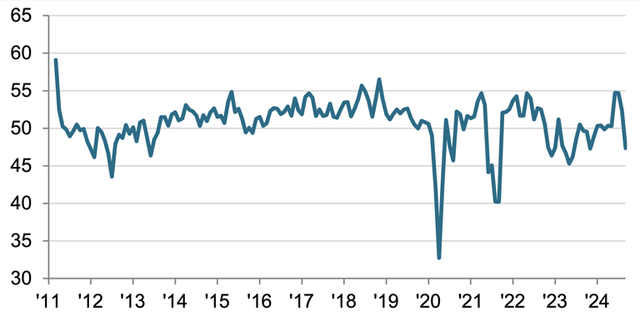Viet Nam’s PMI drops to 47.3 in September due to Typhoon Yagi impact
VGP - Viet Nam Manufacturing Purchasing Managers' Index (PMI) dropped below the 50.0 no-change mark in September due to negative impacts of Typhoon Yagi, according to the S&P Global.

Source: S&P Global PMI (Date collected from September 11 to September 20, 2024)
The index was down to 47.3 from 52.4 in August, with this pointing to the most marked worsening in the health of the sector since November last year.
Typhoon Yagi caused a marked reduction in manufacturing production in September, thereby ending a five-month sequence of expansion.
New export orders dipped, although the rate of contraction was only marginal and much weaker than that seen for total new business as international demand held up relatively well.
With output coupled with new orders down, firms moved to scale back their purchasing activities for the first time in six months. Those manufacturers that did make purchases again during the month were faced with a marked lengthening of suppliers' delivery times as flooding disrupted transportation. As a result, stocks of purchases decreased rapidly.
Disruption to production lines coupled with company closures due to the storm meant that backlogs of work continued to accumulate, with the latest rise in outstanding business being the sharpest in two-and-a-half years. With the disruption caused by typhoon Yagi expected to be only temporary, manufacturers remain optimistic that output will increase over the coming year.
Andrew Harker, economics director at S&P Global Market Intelligence, said "The severity of Typhoon Yagi had a major impact on the Vietnamese manufacturing sector as heavy rain and flooding caused temporary business closures and delays to both supply chains and production lines. The storm brought an end to a period of strong growth in the sector."
Earlier, Typhoon Yagi, the most powerful storm to hit Asia this year, made landfall in northern Viet Nam on September 7, killing hundreds of people and causing widespread damage and flooding.
The typhoon has caused damages worth VND40 trillion (US$1.63 billion) in northern localities and might bring Viet Nam’s 2024 GDP down by 0.15 percentage points from an earlier forecast, according to the government.
The Vietnamese Government however estimated that the storm costs Viet Nam more than US$2 billion

